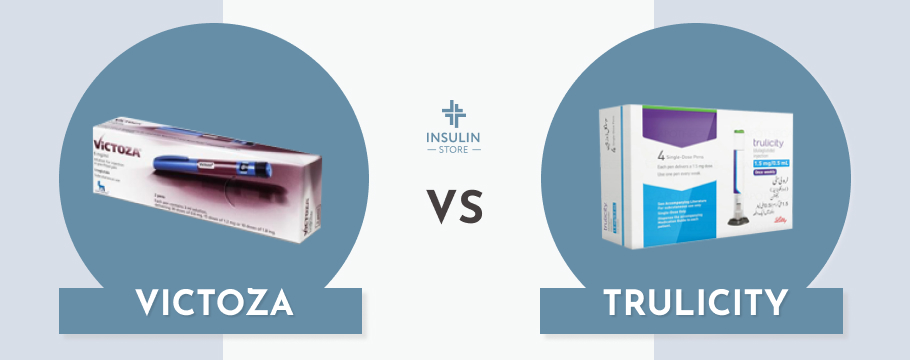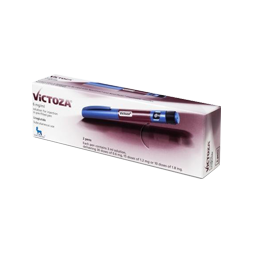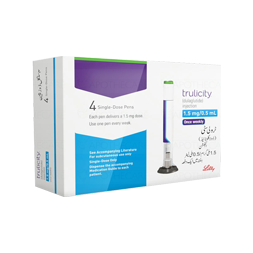
Victoza vs. Trulicity: Which Is Right for You?
In the ever-evolving world of diabetes management, choosing the right medication can be a challenging task. Trulicity and Victoza are two popular options in the treatment of type 2 diabetes, and understanding their differences, similarities, and unique benefits is essential for making an informed decision. This article will guide you through everything you need to know about these two diabetes medications, helping you determine which might be the best fit for your treatment plan. “Is Trulicity better than Victoza?”, “Is Victoza the same as Trulicity?”, – these are two out of the many questions we will search the answers for together!
If you would like to order Trulicity and Victoza (as well as a wide range of other medications of a similar kind) online, check out the assortment of InsulinStore. Here, you will find an extensive range of brand-name insulin products to lower blood sugar levels at reasonable prices.
General Information About Victoza and Trulicity
In order to compare and contrast Trulicity and Victoza, it is essential to check out the general information about them both. So, let us go through the working principle, administration peculiarities, and effectiveness of these products right away.
Trulicity and Victoza are the prescription drug options. Unlike numerous oral medications used to lower blood glucose levels, they have to be administered into the bodies of patients with the help of single-use pens only after healthcare providers authorize these treatment plans.
Victoza
Victoza is a prescription medication that belongs to a class of drugs known as GLP-1 receptor agonists (glucagon-like peptide-1 receptor agonists). It is primarily used to manage blood sugar levels in adults with type 2 diabetes, but it is also approved for reducing the risk of major cardiovascular events in patients with type 2 diabetes and established cardiovascular disease.
How It Works:
Victoza mimics the action of the GLP-1 hormone, which is naturally produced in the body. This hormone helps to regulate blood sugar levels by stimulating insulin secretion in response to meals, reducing the release of glucagon (a hormone that raises blood sugar levels), and slowing the emptying of the gastric tract, which helps prevent blood sugar spikes after eating.
Administration:
Victoza is administered as a once-daily injection. It can be injected at any time of the day, with or without meals, offering flexibility for patients.
Effectiveness:
Clinical studies have shown that Victoza is effective in lowering HbA1c levels (a measure of long-term blood glucose control), with many patients experiencing a reduction of 1-1.5%. Additionally, Victoza has been associated with weight loss, which can be beneficial for many patients with type 2 diabetes.
Trulicity
Trulicity is another GLP-1 receptor agonist used to manage type 2 diabetes. Like Victoza, it helps control blood sugar levels and has been shown to reduce the risk of major cardiovascular events in patients with type 2 diabetes and established cardiovascular disease.
How It Works:
Trulicity works similarly to Victoza by mimicking the GLP-1 hormone. It stimulates insulin release in response to food intake, decreases the amount of glucagon released by the liver, and slows down gastric emptying, helping to maintain steady blood glucose levels.
Administration:
One of the key differences between Trulicity and Victoza is the frequency of administration. Trulicity is administered as a once-weekly injection, making it a convenient option for those who prefer fewer injections.
Effectiveness:
Trulicity has also been shown to be effective in reducing HbA1c levels, with a typical reduction of 1-1.5%. Similar to Victoza, Trulicity may also lead to weight loss in some patients, though the extent of this benefit can vary.
GLP-1 is a naturally occurring hormone the main tasks of which are to stimulate insulin secretion and lower glucagon secretion. By doing so, it has the power to reduce blood sugar levels in a quick and effective way.
Similarities and Differences Between Victoza and Trulicity
After going through the general information about Trulicity and Victoza, it is high time to delve into the Trulicity vs. Victoza comparison. Below, you will find the most important similarities and differences of these two products used to treat diabetes by effectively lowering high blood sugar.
Similarities
Victoza and Trulicity share several similarities, primarily due to their classification as GLP-1 receptor drug class medications. Some of the most notable similarities include:
Mechanism of Action:
Both Victoza and Trulicity function by mimicking the GLP-1 hormone. This shared mechanism helps to regulate blood sugar levels through the stimulation of insulin release, suppression of glucagon secretion, and gastroparesis.
Blood Sugar Control:
Both Trulicity and Victoza are products effective in lowering HbA1c levels, typically resulting in a reduction of 1-1.5%. This makes them strong contenders for achieving better long-term blood sugar control if compared to other medications used for similar purposes.
Cardiovascular Benefits:
As clinical trials show, Victoza and Trulicity have been shown to reduce the risk of major cardiovascular events, such as heart attack and stroke, in patients with type 2 diabetes. This added benefit makes them appealing choices for patients with diabetes who have heart diseases in their personal or family history.
Potential for Weight Loss:
Another similarity between Trulicity and Victoza is their potential to aid in weight loss. Both medications have been shown to modestly help patients lose weight, which can be an important factor for those with type 2 diabetes, as weight management plays a crucial role in overall health and blood sugar control (or, in other words, in the maintenance of normally low blood sugar levels). As numerous diabetes care reports show, the average weight loss of patients treated with Trulicity and Victoza equals 15% of their initial body weight.
Side Effects:
Both medications share similar side effects, with the most common being gastrointestinal issues such as nausea, vomiting, and diarrhea. These side effects are often mild and tend to diminish over time as the body adjusts to the medication. While rare complications of Trulicity and Victoza include severe allergic reactions, hypersensitivity reactions, risks of medullary thyroid cancer, possible thyroid tumors (especially thyroid C cell tumors), kidney problems, major cardiovascular problems, acute renal failure, abdominal pain, and so on. Luckily, these symptoms occur very seldom.
While choosing Trulicity or Victoza as their main injectable medication to maintain normally low blood sugar levels, a patient should be prepared to experience symptoms of decreased appetite together with an upset stomach. This is quite a frequent thing to be prepared for when using a GLP-1 agonist for glycemic control.
Differences
Despite their similarities, Victoza and Trulicity differ in several key aspects, which can influence the decision-making process when choosing between the two and deciding which medication (Trulicity or Victoza) is going to do a better job in each individual case.
Composition
Although Trulicity and Victoza have a quite similar composition that creates decreased appetite and, therefore, leads to normally low blood sugar levels, the two products are not identical. Namely, Trulicity includes the active ingredient dulaglutide, while Victoza possesses the active ingredient liraglutide.
Frequency of Administration:
One of the most significant differences is the frequency of injections (no matter whether we are talking about the lower or the higher doses of the products). Victoza is administered into the human body daily, while Trulicity is administered once a week. This difference in dosing frequency may be a deciding factor for patients who prefer a less frequent injection schedule.
Onset of Action:
Victoza is a new medication that has a relatively quick onset of action, with blood sugar levels beginning to decrease within a few hours of the first injection. Trulicity, on the other hand, has a slower onset of action, taking a few days to reach its full effect. This difference might be important for patients who need immediate blood sugar control right after the first dose has been administered.
Storage and Stability:
Victoza and Trulicity also differ in their storage requirements. Victoza should be refrigerated before first use but can be kept at room temperature for up to 30 days after opening. Trulicity, on the other hand, must be stored in the refrigerator but can be kept at room temperature for up to 14 days before use. Patients who travel frequently or have limited access to refrigeration may prefer one option over the other based on these requirements.
Formulation and Needle Size:
Trulicity comes in a pre-filled pen with a built-in needle, designed for easy and discreet administration. Victoza also comes in a pen form, but the needle must be attached separately. Additionally, Trulicity’s needle is generally smaller, which some patients may find more comfortable.
Cost:
Cost can be a significant factor for many patients. While both Victoza and Trulicity are brand-name drugs and can be expensive, the actual cost to the patient can vary depending on insurance coverage, co-pays, and available discounts. It is important for patients to discuss cost considerations with their healthcare provider or pharmacist to determine which option is more affordable for them.
No matter whether you use Trulicity or Victoza for your blood sugar control, you should undergo the routine monitoring of serum calcitonin on a regular basis. This way, it will be possible to prevent such medical conditions as poor renal function, kidney failure (as well as other kidney problems), or even thyroid cancer.
When to Choose Victoza or Trulicity
To avoid harmful drug interactions, it is essential not to use Trulicity and Victoza simultaneously but rather choose one of them (although they both belong to the same drug class). Below, you will be able to check out the circumstances under which it might be preferable to go with Trulicity or Victoza.
Choosing Victoza
Victoza might be the better option for you if:
- You prefer daily administration: If you are comfortable with or prefer a daily injection routine, Victoza’s once-daily dosing schedule might suit you better.
- You need quick blood sugar control: Victoza has a faster onset of action, making it a good choice for patients who need immediate blood sugar management.
- You require more flexibility in storage: If you need a medication that can be stored at room temperature for a longer period (up to 30 days after first use), Victoza offers more flexibility compared to Trulicity.
- You have specific cardiovascular concerns: While both medications offer cardiovascular benefits, your healthcare provider may recommend Victoza based on your specific cardiovascular health profile.
Choosing Trulicity
Trulicity might be the right choice for you if:
- You prefer fewer injections: Trulicity’s once-weekly dosing schedule is ideal for patients who prefer or require a less frequent injection regimen.
- You seek convenience in administration: Trulicity’s pre-filled pen with a built-in needle offers a more straightforward and less invasive injection process.
- You don’t require immediate blood sugar control: If your blood sugar levels are stable and you don’t need medication with a rapid onset, Trulicity’s slower action might not be a concern.
- You have specific storage needs: While Trulicity has more stringent refrigeration requirements, it may still be a suitable option if your lifestyle supports these needs.
- Cost considerations: Depending on your health insurance type and available discounts, Trulicity may be more affordable, making it a more accessible option.
Please note that both Trulicity and Victoza are going to be optimal choices for those patients who are currently looking for injectable products to help the pancreas produce more insulin to regulate blood sugar levels.
To Sum Up
Choosing between Victoza and Trulicity is a decision that should be made based on your individual needs, lifestyle, and medical profile. Both medications offer significant benefits for managing type 2 diabetes, including effective blood sugar control, cardiovascular protection, and potential weight loss. The key differences in dosing frequency, onset of action, storage requirements, and administration may guide your decision.
It’s crucial to have an open and thorough discussion with your healthcare provider about your preferences, health goals, and any concerns you may have. Your healthcare provider can help you weigh the pros and cons of each medication, ensuring that you choose the option that aligns best with your health needs and lifestyle. Whether you opt for Victoza or Trulicity, both are powerful tools in the ongoing management of type 2 diabetes, helping you achieve better blood sugar control and overall health.

